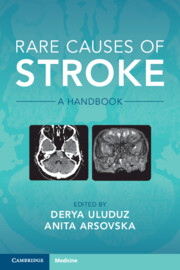Book contents
- Rare Causes of Stroke
- Rare Causes of Stroke
- Copyright page
- Contents
- Contributors
- Preface
- 1 Inflammatory Conditions
- 2 Infectious and Postinfectious Vasculitis
- 3 Hypercoagulable Causes of Stroke
- 4 Drug-Related Stroke
- 5 Hereditary and Genetic Causes of Stroke
- 6 Rare Causes of Cardioembolism
- 7 Vasospastic Conditions and Other Vasculopathies
- Chapter 7.1 Reversible Cerebral Vasoconstriction Syndrome
- Chapter 7.2 Eclampsia and Strokes during Pregnancy and Postpartum
- Chapter 7.3 Migraines and Migraine-Like Conditions
- 8 Other Non-inflammatory Vasculopathies
- 9 Venous Occlusive Conditions
- 10 Bone Disorders and Stroke
- Index
- References
Chapter 7.1 - Reversible Cerebral Vasoconstriction Syndrome
from 7 - Vasospastic Conditions and Other Vasculopathies
Published online by Cambridge University Press: 06 October 2022
- Rare Causes of Stroke
- Rare Causes of Stroke
- Copyright page
- Contents
- Contributors
- Preface
- 1 Inflammatory Conditions
- 2 Infectious and Postinfectious Vasculitis
- 3 Hypercoagulable Causes of Stroke
- 4 Drug-Related Stroke
- 5 Hereditary and Genetic Causes of Stroke
- 6 Rare Causes of Cardioembolism
- 7 Vasospastic Conditions and Other Vasculopathies
- Chapter 7.1 Reversible Cerebral Vasoconstriction Syndrome
- Chapter 7.2 Eclampsia and Strokes during Pregnancy and Postpartum
- Chapter 7.3 Migraines and Migraine-Like Conditions
- 8 Other Non-inflammatory Vasculopathies
- 9 Venous Occlusive Conditions
- 10 Bone Disorders and Stroke
- Index
- References
Summary
RCVS is a clinical radiological syndrome that typically presents with severe headache, with or without other neurological symptoms, and is associated with diffuse multifocal cerebral vasoconstriction that resolves spontaneously within 3 months. Most of the RCVS cases are associated with vasoactive medications, recreational drugs, pregnancy and postpartum state and migraine headaches.It usually begins with an acute, extremely severe thunderclap headache, like a headache in subarachnoid hemorrhage. Epileptic seizures have been reported and focal neurological deficit may present as a TIA or with visual disturbances. In more than 90% of patients, complete withdrawal of symptoms occur, but RCVS may be complicated with cerebral infarction, intracerebral hemorrhage, subarachnoid hemorrhage, or posterior reversible encephalopathy syndrome.Rarely, these complications lead to death. Catheter angiography, MR angiography or CT angiography may disclose a “string-of-beads” and “sausage and strings” appearance of vessels. In the treatment of cerebral vasospasm, the use of calcium channel blockers for about 4-8 weeks may be considered
Keywords
- Type
- Chapter
- Information
- Rare Causes of StrokeA Handbook, pp. 293 - 298Publisher: Cambridge University PressPrint publication year: 2022

